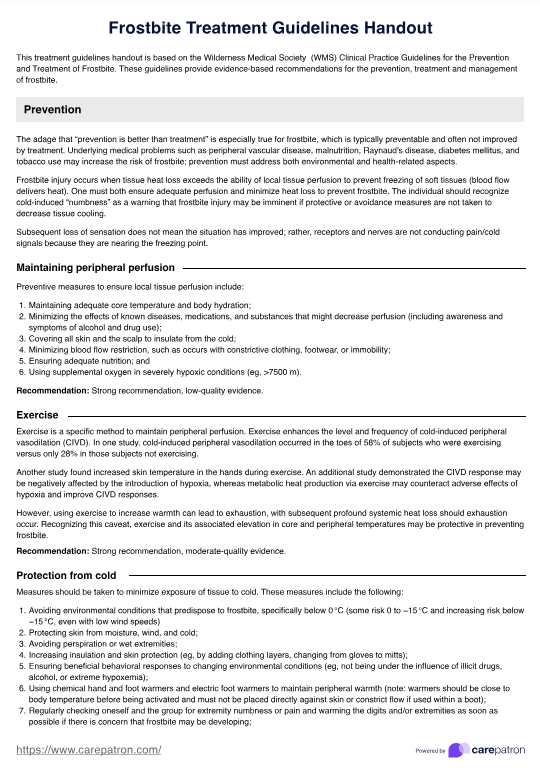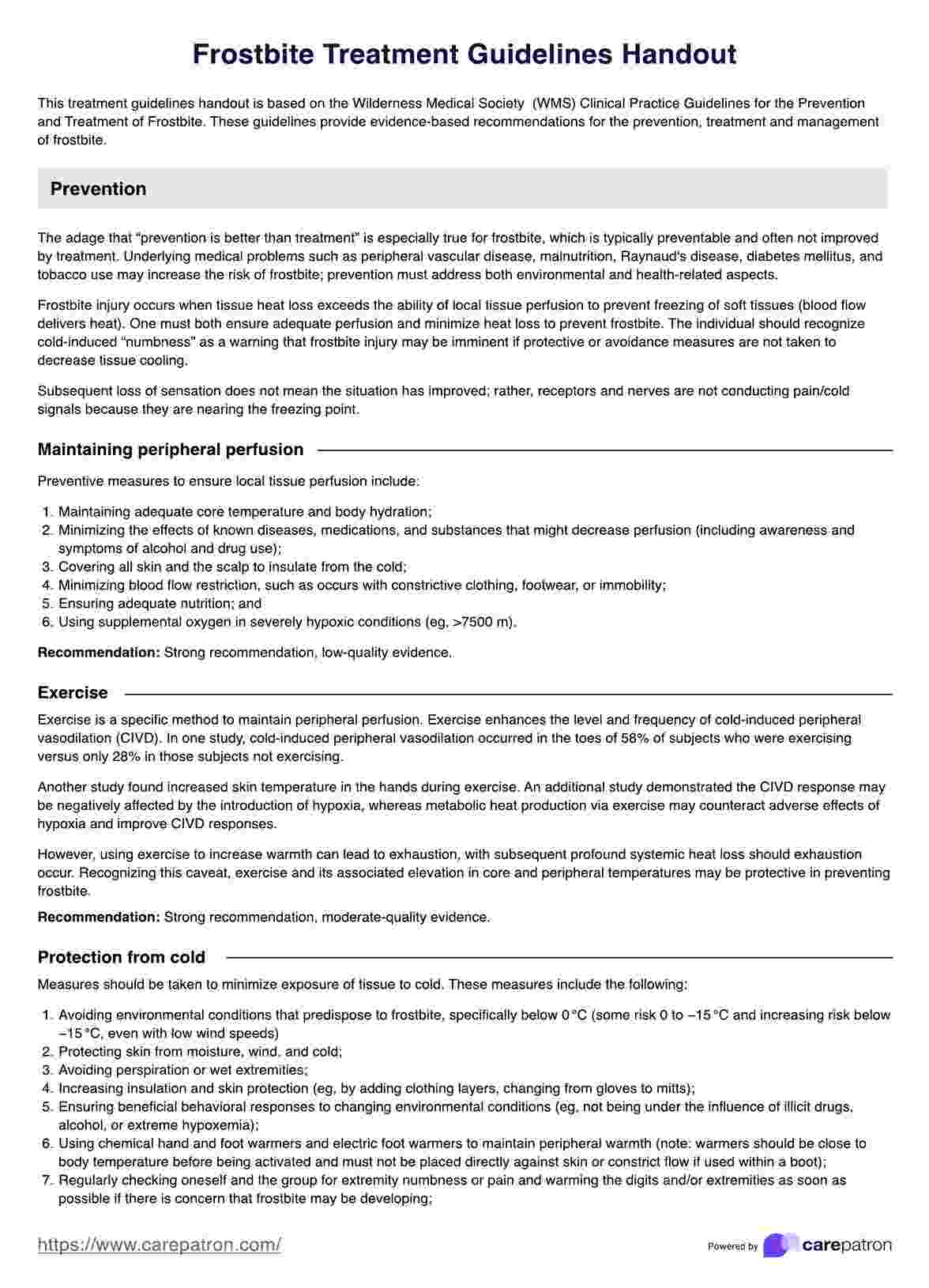Frostbite Treatment Guidelines Handout
Use our comprehensive guidelines handout to learn how to manage and treat frostbite effectively. It is perfect for healthcare professionals who deal with cold injuries and cold skin.


What is frostbite?
Frostbite occurs when your skin and the tissues beneath it freeze due to prolonged exposure to cold temperatures. This condition can affect any body part, but fingers, toes, ears, and nose are particularly vulnerable. Frostbite ranges from mild (frostnip) to severe, potentially causing permanent damage if not treated promptly. Understanding frostbite's signs, symptoms, and treatment is crucial, especially for those who spend significant time outdoors in cold weather.
Causes of frostbite
Frostbite is primarily caused by exposure to cold weather, particularly when wet clothing or inadequate protection exposes your skin to the elements. Other factors include:
- Cold exposure: Prolonged time spent in freezing or near-freezing temperatures can lead to frostbite.
- Wind chill: High winds can remove the layer of heated air around your skin, accelerating heat loss.
- Wet clothing: Wearing wet clothing in cold weather significantly increases the risk as it draws heat away from the body.
- Poor circulation: Conditions that impair blood flow, such as diabetes or cardiovascular disease, increase susceptibility to frostbite.
Symptoms and signs of frostbite
Frostbite can be categorized into several stages, each with distinct symptoms:
- Frostnip (mild frostbite): The earliest stage, causing pale or red skin, numbness, and tingling. The skin remains pliable and can be treated by rewarming.
- Superficial frostbite: Affects the outer layers of the skin, which may turn white or pale. Ice crystals can form in the tissue, causing the skin to feel hard. Blisters may appear after rewarming.
- Deep frostbite (severe frostbite): This stage involves all layers of the skin and underlying tissues. The skin may turn blue or black, and deep blisters form. Permanent damage to blood vessels and nerves can lead to dead tissue.
Frostbite Treatment Guidelines Handout Template
Frostbite Treatment Guidelines Handout Example
How do healthcare professionals treat frostbite?
There are several ways frostbites can be treated by a professional, including:
Rapid rewarming
The primary treatment for frostbite involves rewarming the affected area. This is done by immersing the frostbitten skin in warm (not hot) water, typically between 37°C and 39°C (98.6°F to 102.2°F), for 15-30 minutes. It's crucial to avoid dry heat sources like a heating pad or fires, which can cause burns. A warm blanket can help maintain the proper body temperature during this process.
Pain management
Rewarming can be painful so that healthcare providers may administer pain relievers such as ibuprofen. These medications also help reduce inflammation and prevent further damage.
Protecting frostbitten skin
After rewarming, the affected skin should be kept clean and dry. Applying sterile dressings and avoiding pressure on the frostbitten area helps prevent infection and promotes healing. Blisters should not be burst as they protect the underlying tissues.
Medications
In severe frostbite cases, doctors might prescribe thrombolytic agents to dissolve blood clots and improve blood flow. Additionally, vasodilators can help expand blood vessels, enhancing circulation to the affected areas.
Wound care and debridement
Proper wound care is vital for healing. This involves cleaning the frostbitten skin and removing dead tissue, a process known as debridement. In cases of deep frostbite, surgical intervention may be necessary to remove necrotic tissue and prevent infection.
Monitoring for complications
Healthcare providers closely monitor patients for potential complications, such as infections or permanent damage to the skin, muscles, and bones. In some cases, frostbite can lead to long-term issues, including chronic pain, sensory loss, and arthritis.
Commonly asked questions
When a patient presents with frostbite, quickly move them to a warm environment and rewarm the affected areas by immersing them in warm water (37°C to 39°C). Avoid dry heat sources and ensure the patient stays warm with blankets.
Administer pain relievers such as ibuprofen to manage pain and reduce inflammation during rewarming. Ensure continuous monitoring and comfort for the patient.
Blue or black skin, deep blisters, a hard or waxy skin texture, and loss of sensation indicate severe frostbite. Immediate, advanced medical intervention is needed to prevent permanent damage.

.jpg)





































































































